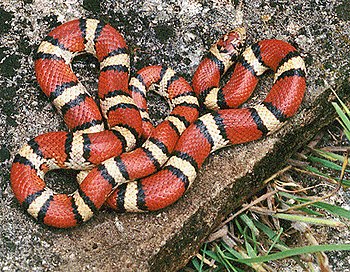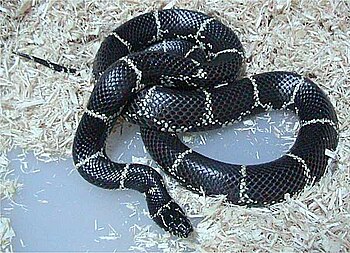Have you been considering purchasing a snake as a pet? There are many different types of snakes available at specialty pet stores. But, if this is your first pet snake, you might want to consider purchasing a king snake or a milk snake. There are numerous sub-species that fall into these two closely-related snakes; this means you will have a variety of different colors and patterns to choose from. In addition, these snakes are generally non-aggressive and easy to care for.
Getting to Know the King Snake and the Milk Snake
 |
| Red milk snake (Lampropeltis triangulum syspila) (Photo credit: Wikipedia) |
King snakes and milk snakes are interesting creatures for a number of different reasons. For starters, the colors and patterns found on some of these snakes can look very similar coral snakes, which are very venomous snakes with yellow and red bands of color. In fact, the only real difference in appearance between a coral snake and a king or milk snake with the same coloring is the act that king and milk snakes have a line of black touching the red bands.
Another interesting characteristic of king snakes and milk snakes is the fact that they actually eat other snakes as well as lizards, rodents, amphibians, and birds. Of course, as the owner of a king snake or milk snake, you would not feed other snakes to your pet. Not only would this be quite expensive for you, but it would also be potentially dangerous to your snake as well. Nonetheless, when surviving in the wild, king snakes and milk snakes can actually eat snakes that are larger than they are. In fact, it is not uncommon for some to regularly eat rattlesnakes in the wild. Therefore, you should never put more than one king snake or milk snake in the same aquarium, as one will be certain to make a meal out of the other.
Housing a King Snake or a Milk Snake
 |
| Eastern Kingsnake, Lampropeltis getula getula (Photo credit: Wikipedia) |
Since king snakes and milk snakes can reach six to seven feet in length, it is important to select a terrarium that is large enough for them to grow and to rest comfortably inside. When they are young, a 10-gallon tank may be sufficient. A full-grown snake, however, should be provided a 60-gallon tank in which it can stretch and move about, as king snakes and milk snakes tend to be quite active.
When selecting a terrarium for a king snake or a milk snake, it is also very important to select one that can be secured tightly. These snakes have a reputation for getting out of their cages and for squeezing through even the smallest places. So, spend a little extra on a terrarium with a top that can be latched.
Maintaining the proper temperature is also important when it comes to keeping your snake healthy. Milk snakes and king snakes generally like their cages to be around 76 to 86 degrees Fahrenheit during the day, but the temperature should drop down to about 70 to 74 degrees Fahrenheit at night. At the same time, you should take measures to provide different temperatures within the cage so your snake can move from one area to the next in order to regulate its temperature.
It is important to note that the needs of various varieties of milk snakes and king snakes can differ. Therefore, you should be certain to research the specific type of snake you are considering purchasing in order to make certain you set its home up properly and give it the best chance of living a long and healthy life.
|

No comments:
Post a Comment